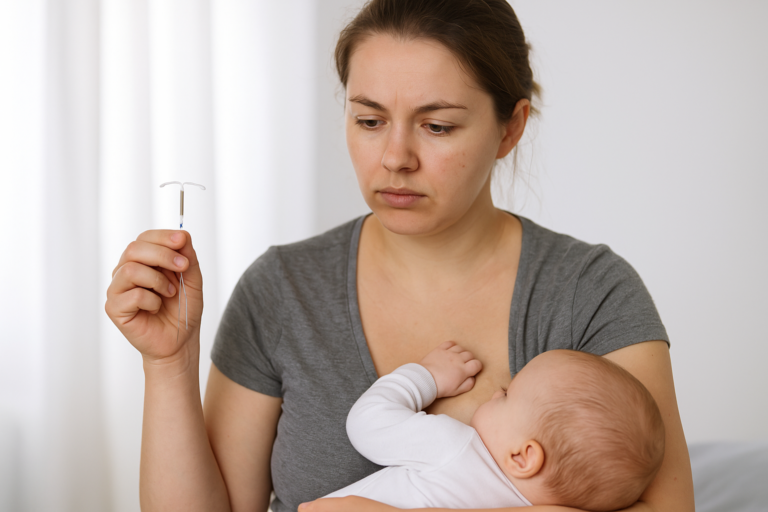Intrauterine devices (IUDs) are small, T-shaped contraceptives placed inside the uterus to prevent pregnancy. As a long-acting, reversible method, they are commonly considered by women in the postpartum period due to their convenience and effectiveness. For new mothers who are breastfeeding, however, the question often arises: is using an IUD compatible with breastfeeding?
This article explores the suitability of IUDs during breastfeeding. We will examine the types of IUDs available, how they may affect milk supply, any potential impact on the baby, and when they can be safely inserted after childbirth. All information provided is based on current clinical guidance and aims to support informed discussions with your healthcare provider. You can learn more about our clinic through a personalised consultation.
Can You Use an IUD While Breastfeeding?
A common concern among new mothers is whether using an intrauterine device is appropriate during the breastfeeding period. Both hormonal and non-hormonal IUDs are generally considered compatible with breastfeeding. PubMed support the use of IUDs among breastfeeding individuals, noting no evidence of harm when used correctly under medical supervision.
These devices provide a convenient contraception option without requiring daily attention, which can be especially beneficial during the demanding early months of parenthood. Let’s examine specific concerns about safety for the baby and potential effects on milk supply.
Is It Safe for the Baby?
Studies have shown no known adverse effects on infant growth, behaviour, or neurological development when mothers use hormonal IUDs during breastfeeding. While ongoing research continues to monitor outcomes, current findings indicate that both hormonal and non-hormonal IUDs do not pose a known risk to breastfed babies.
Does It Affect Milk Supply?
Both copper (non-hormonal) and hormonal IUDs are commonly used by breastfeeding mothers without major issues related to milk production. Concerns often arise around hormonal IUDs, particularly whether the progestin they release could reduce supply. However, research to date does not support the idea that these IUDs significantly impact milk quantity.
While some mothers worry that hormonal birth control may cause their milk to “dry up,” hormonal IUDs do not typically affect supply in a clinically meaningful way. Breastfeeding continuation rates remain similar between users and non-users of IUDs, reinforcing the view that these contraceptive methods are compatible with breastfeeding for most women.
When Can You Get an IUD After Giving Birth?

The right time to have an IUD inserted after childbirth varies from person to person. Factors such as the mode of delivery, how your body is healing, and whether there were any complications can all influence the safest and most suitable timing.
Rather than relying on a set timeline, your doctor will assess your recovery and reproductive health needs before recommending when to proceed with IUD insertion. This ensures that the placement is safe, comfortable, and effective for your individual circumstances.
Which Type of IUD Is Better While Breastfeeding?
When considering an IUD during breastfeeding, both hormonal and non-hormonal options are available. Neither is inherently “better,” but each type has specific features that may align differently with your postpartum and breastfeeding needs. Understanding their mechanisms, side effects, and compatibility with breastfeeding can help guide your discussion with your healthcare provider.
Let’s compare the copper and hormonal IUDs based on their characteristics.
Copper IUD (Non-Hormonal)
The copper IUD does not contain any hormones, making it a suitable option for those who prefer to avoid hormonal contraceptives during breastfeeding. It works by releasing copper ions, which interfere with sperm movement and fertilisation.
Key Points:
- No hormonal component, eliminating the possibility of hormone-related effects on milk production
- Long-lasting effectiveness (up to 10 years depending on the model)
Consideration:
- May cause heavier or longer menstrual periods, which some mothers may find inconvenient during the early stages of motherhood
This non-hormonal option is generally well-tolerated and often preferred by those who have concerns about hormone exposure during breastfeeding.
Hormonal IUD (Progestin-Releasing)
Hormonal IUDs release a small amount of progestin directly into the uterus. This hormone thickens cervical mucus and thins the uterine lining to prevent pregnancy. Because the hormone is released locally, systemic absorption is minimal, and studies support its compatibility with breastfeeding.
Key Points:
- Progestin is released in low doses and has not been shown to adversely affect milk supply
- May reduce menstrual bleeding, which some mothers find helpful in the postpartum period
- Typically has a lower expulsion rate compared to the copper IUD
This option may appeal to women seeking a reduction in menstrual flow while maintaining contraceptive protection during breastfeeding. It’s important to consult your doctor to determine if a hormonal IUD aligns with your health profile and postpartum needs.
Are There Any Risks to Using an IUD After Giving Birth?

Yes, while IUDs are commonly used postpartum and are generally considered suitable for many women, there are a few potential risks to be aware of. These risks are rare and typically manageable under medical care, but they may be more pronounced when the device is inserted soon after childbirth. Understanding these risks can help you make an informed decision in consultation with your healthcare provider.
Let’s take a closer look at two key concerns associated with IUD use after giving birth.
IUD Expulsion Risk
IUD expulsion refers to the device being partially or completely pushed out of the uterus. This risk is higher when the IUD is inserted immediately after childbirth, due to the uterus still being enlarged and in the process of returning to its pre-pregnancy size.
Key Considerations:
- Expulsion is more likely in the early postpartum period
- The risk tends to decrease when the IUD is inserted at six weeks postpartum or later
- Regular follow-ups can help ensure the device remains properly positioned
While expulsion does not occur frequently, it is important to be aware of signs such as unusual bleeding, pain, or the feeling that the IUD has shifted. Your healthcare provider can assess and manage this if it occurs.
Uterine Perforation (Rare)
Uterine perforation is an uncommon but recognised risk where the IUD punctures the wall of the uterus during insertion. This complication occurs in a very small number of cases and is slightly more likely among breastfeeding women due to physiological changes after birth.
Why It Can Happen:
- The uterine wall may be softer in the early postpartum period
- Lower estrogen levels during breastfeeding may also increase susceptibility
What to Expect:
- Most perforations are identified early and managed by a healthcare provider
- If suspected, imaging and prompt medical attention ensure appropriate treatment
Although rare, this is a serious consideration that underscores the importance of skilled insertion and close monitoring after placement.
Benefits of Using an IUD While Breastfeeding
For many women, using an IUD during breastfeeding offers practical advantages. These devices are long-acting, reversible, and require minimal daily effort—features that can be especially valuable during the busy postpartum period. While individual suitability should always be confirmed with a healthcare provider, the following are potential benefits:
- Long-acting contraception, effective for 3 to 10 years depending on the type
- Over 99% effective at preventing pregnancy
- No need for daily maintenance or user-dependent action
- Can be used alongside breastfeeding amenorrhea (temporary natural infertility from exclusive breastfeeding)
- Suitable for those who have delivered vaginally or via caesarean section
What Should You Discuss With Your Doctor?
Before choosing an IUD while breastfeeding, it’s essential to consult with your healthcare provider. A personalised discussion can help determine if an IUD is appropriate for your medical history, breastfeeding status, and family planning goals. Here are key topics to bring up during your consultation:
Personal Health History
- Details of previous pregnancies, including whether you had a vaginal or caesarean delivery
- Any underlying health conditions or complications from childbirth
- Sensitivity to hormonal changes or past experiences with menstrual patterns
Family Planning Goals

- Whether you are seeking short-term or long-term contraception
- Your breastfeeding approach—exclusively nursing or supplementing
- Your comfort with hormone-based contraceptive methods
These discussions can guide a shared decision-making process with your doctor to ensure that your postpartum contraception aligns with both your health and your personal preferences.
FAQs About Using IUD While Breastfeeding
Can the IUD be inserted during a C-section?
Yes, in some cases. Immediate insertion during a caesarean delivery may be available depending on your hospital’s protocol and your doctor’s assessment.
Will the IUD affect bonding or my baby’s temperament?
There is no current evidence to suggest that IUD use impacts maternal-infant bonding or a baby’s emotional or behavioural development.
Is the insertion more painful if I’m breastfeeding?
Some women report increased uterine sensitivity while breastfeeding due to hormonal changes. Your doctor can discuss options for managing discomfort during the procedure.
Conclusion
Intrauterine devices are widely used by breastfeeding mothers and are generally considered suitable for postpartum contraception. Both copper and hormonal IUDs offer long-term, effective options without the need for daily attention—features that can support the demands of new parenthood.
While each type of IUD has its own characteristics and potential side effects, current evidence does not indicate harm to breastfeeding or infant development. However, as with any medical decision, it’s important to consult your healthcare provider. A personalised evaluation will help determine the most appropriate timing and type of IUD based on your health, breastfeeding goals, and family planning needs.








